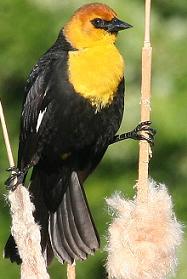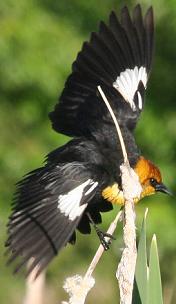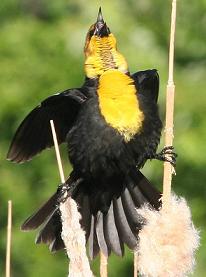Yellow-headed Blackbird 
Identification and Pictures
(Genus: Xanthocephalus)
Usually perched on a Cattail, Yellow-headed blackbirds are marsh birds, about the size of a
robin (9 to 9 3/4 inches). The most
striking feature of the adult male is its yellow or orange-yellow
head and breast, which stands out against a mostly black body.
 They
have a pointed black bill, and a white wing patch is visible at the right angle or while the bird is in
flight. Young males are brownish with red shoulder patches.
They
have a pointed black bill, and a white wing patch is visible at the right angle or while the bird is in
flight. Young males are brownish with red shoulder patches.
The female is brownish with a dull yellow throat and breast with white streaks.
Photos by Keith Lee. The camera I use is
the Canon EOS
40D and a 70 to 300 zoom lens.

Songs and Calls
The song consists of low hoarse rasping notes almost like a
rusty hinge. They also call a very distinctive low (kruuck)
sound. Their unique, loud song helps in locating them in
a marsh.
Yellow-headed
blackbird sound
Range and Habitat
Yellow-headed blackbirds range across much of the west-central portions of Canada, and the United
States, inhabiting freshwater marshes, and wetlands in summer
breeding season. They winter from California, and Texas through Mexico.
They like large wetlands with deep water. They are
often present in areas with Red-winged
blackbirds, preferring
the center of the marsh.
The birds will live in open fields during the non-breeding season.
They form large flocks often mixed with other blackbirds.
In the winter these flocks may consist of only males or females.
Blackbird flocks will fly in what looks like large flowing waves, where the birds in the back fly over the rest of the flock.
Breeding and Nesting
Males arrive at the breeding area first and will sit on top
of cattails or other reeds singing with a spread tail and half-open wings.
They breed in colonies with males usually having 3 to 4 mates at one time, however they can have 6 or more. These pairs will only
last for 1 breeding season. The nest is a woven cup of grass, stems, and leaves which the female secures to cattails, reeds or other
aquatic vegetation, about 1/2 feet above the water. She will
incubate 3 to 5 greenish-white eggs with dark blotches for 12 to 14 days.
The male may help, but the female does most of the feeding.
The young birds will leave the nest in around 12 days, staying near water until
they can fly. She will usually only have one brood for the season but may have
two.
Food
Foraging in fields and marshes they eat seeds and insects.
Learn about other favorite
backyard birds.

|
